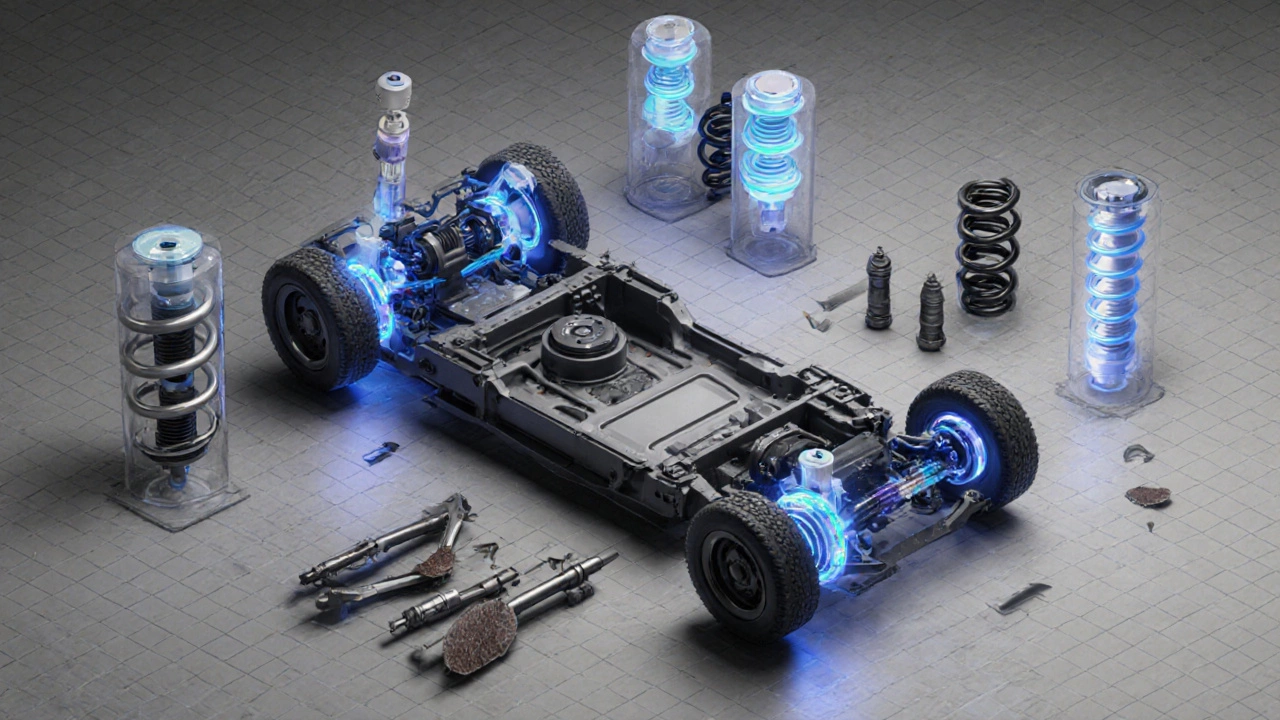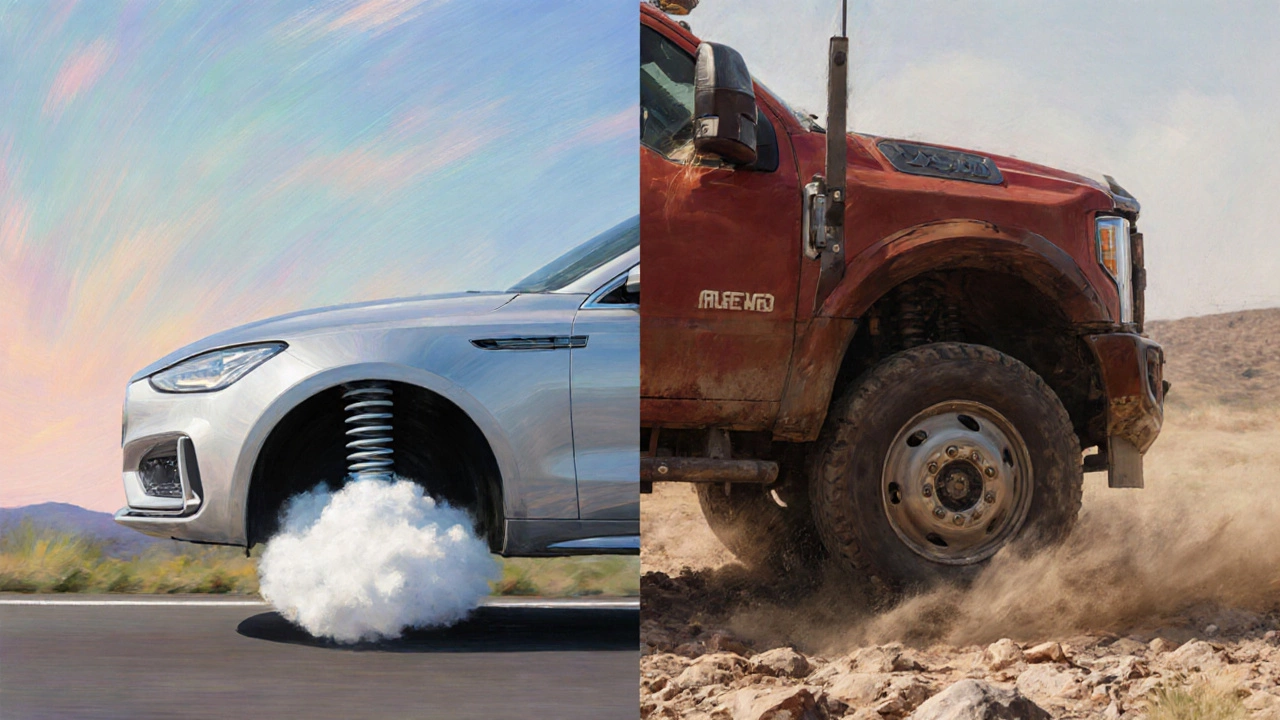 Oct, 9 2025
Oct, 9 2025
Suspension Comfort Comparison Tool
Comfort Analysis
Select suspension type and driving style, then click "Compare Suspension Comfort" to see detailed analysis.
When you think about a comfortable drive, the smoothest ride suspension is often the secret hero. Car suspension is a system of springs, shock absorbers, and linkages that connects a vehicle’s chassis to its wheels, controlling how bumps, dips, and road imperfections are felt inside the cabin. It’s not just about staying glued to the road; it’s about turning those rough patches into a gentle glide. Below you’ll discover which suspension designs truly make that happen, how they differ, and what to look for when you’re shopping for a smoother ride.
Key Takeaways
- Air and hydraulic suspensions deliver the softest ride but come with higher cost and complexity.
- MacPherson struts are common and affordable, offering decent comfort for everyday cars.
- Double‑wishbone and multilink setups provide excellent balance between comfort and handling, especially on performance models.
- Coil springs paired with quality shock absorbers remain a reliable, low‑maintenance choice.
- Maintenance matters - worn bushings or leaks can quickly ruin an otherwise smooth system.
How Suspension Influences Ride Comfort
Every time your tires meet the road, the suspension decides how much of that energy reaches the seats. Two key factors matter: spring stiffness (how much the spring compresses) and damping (how quickly the shock absorber dissipates movement). Soft springs can soak up bumps, but if the damping is too weak the car will bounce like a pogo stick. Too stiff a spring makes the ride feel harsh, even with good shocks.
Besides springs and shocks, the geometry of the suspension - the way arms and linkages are arranged - influences how the wheels stay in contact with the road. A well‑tuned geometry keeps the tire patch flat, reducing vibration and noise inside the cabin.
So, a smooth ride isn’t just about “soft” parts; it’s about the right combination of spring rate, damper tuning, and geometry working together.

Major Suspension Types and Their Comfort Profiles
Air Suspension
Air suspension uses inflatable rubber bags instead of traditional steel springs. Sensors constantly monitor ride height and adjust air pressure to keep the vehicle level, regardless of load. The result is a feather‑light feel on city streets and the ability to raise the car for off‑road or heavy‑load situations. Luxury brands like Mercedes‑Benz and Audi make air‑suspended models for precisely this reason - the cabin feels like a floating cloud.
Hydraulic Suspension
Hydraulic suspension employs fluid‑filled cylinders that can be actively controlled. By varying fluid pressure, the system can soften or stiffen on the fly. Sports cars such as the Corvette ZR1 use hydraulic setups for rapid ride‑height changes during cornering, yet they also provide a surprisingly plush ride when cruising.
MacPherson Strut
MacPherson strut combines a shock absorber and a coil spring into a single, compact unit. It dominates front‑suspension design on compact and midsize cars because it’s cheap and space‑efficient. While not the softest, modern tuned struts paired with progressive‑rate coil springs can deliver a comfortable daily drive.
Double‑Wishbone
Double‑wishbone suspension uses two triangular arms (upper and lower) to control wheel motion. This geometry allows engineers to fine‑tune camber changes, which reduces tire chatter on uneven roads. High‑end sedans and performance coupes often use double‑wishbone setups because they balance a plush ride with sharp handling.
Multilink
Multilink suspension consists of several arms that can be individually adjusted. It offers the most flexibility in aligning wheel travel, making it a favorite for luxury SUVs and sporty sedans. When paired with soft coil springs, multilink systems can be incredibly comfortable while still keeping the car planted.
Coil Spring + Shock
Coil spring is the most common spring type, made of coiled steel that compresses under load. Coupled with a well‑matched shock absorber, this simple combo provides reliable comfort for the vast majority of vehicles. The key is choosing progressive‑rate coils and dampers tuned for your driving style.
Leaf Spring
Leaf spring consists of stacked steel strips that flex as a unit. Mostly found on trucks and older vans, leaf springs are sturdy but can feel firm. Modern leaf‑spring designs incorporate rubber pads or air bags to soften the ride, but they generally don’t match the smoothness of coil‑based systems.
Shock Absorber (Damper)
Shock absorber controls the speed at which the spring rebounds. Whether it’s a monotube, twin‑tube, or adjustable coil‑over, the damper’s tuning is critical. A high‑quality shock can turn a mediocre spring into a comfortable ride, while a cheap shock will make any setup feel harsh.
Comparison of Popular Suspension Designs
| Suspension Type | Ride Comfort Rating* (1‑10) | Typical Cost (US$) | Adjustability | Common Applications | Maintenance Frequency |
|---|---|---|---|---|---|
| Air Suspension | 9 | 3,000-8,000 | High (auto‑level, height control) | Luxury sedans, high‑end SUVs | Every 24-36months (airbag & compressor check) |
| Hydraulic Suspension | 8.5 | 2,500-7,000 | High (active damping) | Sports cars, performance coupes | Every 18-30months (fluid flush) |
| MacPherson Strut | 6.5 | 400-1,200 | Low‑Medium (spring swap only) | Compact & midsize cars | Every 24months (strut & bearing check) |
| Double‑Wishbone | 7.5 | 1,200-3,500 | Medium (adjustable camber) | Performance sedans, sports cars | Every 24months (bushing inspection) |
| Multilink | 8 | 1,500-4,000 | High (multiple arm tweaks) | Luxury SUVs, premium sedans | Every 24-36months (joint lubrication) |
| Coil Spring + Shock | 7 | 300-1,000 | Medium (spring & damper swap) | Most mainstream vehicles | Every 12-24months (shock wear check) |
| Leaf Spring | 5.5 | 200-800 | Low (spring leaf replacement) | Trucks, vans, older pickups | Every 24months (leaf wear inspection) |
*Ratings are based on a combination of manufacturer data, independent road‑test results, and owner feedback collected up to 2025.

Choosing the Right Suspension for Your Needs
Think about how you use your car daily. If you spend most of your time on smooth highways and love a plush cabin, an air‑based system is worth the investment. It automatically compensates for passenger weight, cargo, and even road grade, keeping the ride level.
Do you prefer a bit more driver involvement and want a cheaper solution? A MacPherson strut with upgraded progressive‑rate coils and performance‑grade shocks can surprise you with a comfortable yet responsive feel.
For those who need both comfort and occasional off‑road capability-like a family SUV that tackles snowy backroads-a multilink with optional air‑bag inserts offers an excellent compromise.
Budget‑conscious owners of older trucks often keep leaf springs because they’re cheap and rugged. Adding rubber pads or a light‑weight air helper bag can trim a few points off the harshness without a full conversion.
Finally, remember that a well‑tuned suspension is a partnership: the spring does the heavy lifting, the damper finishes the job, and the geometry ensures the wheels stay in the right place. Ignoring any one of those pieces will degrade ride quality.
Maintenance Tips to Keep Your Ride Smooth
- Inspect bushings and mounts every 12months. Worn rubber can transmit chassis vibration directly to the cabin.
- Check for air leaks in air‑suspended cars. A slow‑leaking bag will cause the car to sag and feel harsher.
- Flush hydraulic fluid according to the manufacturer’s schedule (usually 18-30months). Contaminated fluid reduces damping effectiveness.
- Replace shocks when they show oil seepage, excessive bounce, or uneven wear on tires.
- Balance spring rates after major modifications (e.g., larger wheels). A mismatched spring can make the ride feel either too soft or too stiff.
Good maintenance not only preserves comfort but also extends component life, saving you money in the long run.
Frequently Asked Questions
Can I convert a MacPherson strut car to air suspension?
Yes, kits exist for many models, but the conversion is complex. You’ll need new air bags, compressors, height sensors, and a central control module. labour costs can exceed $2,000, so weigh the comfort gain against the expense.
Which suspension is best for heavy loads?
Leaf springs are traditionally favored for heavy‑load trucks because they distribute weight over a larger area. However, air‑suspended trucks now offer adjustable ride height that can handle loads while keeping a comfortable cabin.
Do performance shocks make a ride softer?
Performance shocks are usually tuned for firmer damping to improve handling. For a softer feel, look for “comfort‑oriented” or “adjustable” shocks that let you dial down the compression rate.
How often should I replace my coil springs?
Coil springs can last 100,000km or more if they’re not overstressed. Signs of failure include sagging, uneven ride height, or a noticeable “bottom‑out” feeling. Replace them when you see these symptoms.
Is a softer suspension always safer?
Not necessarily. A suspension that’s too soft can increase body roll, lengthen stopping distance, and reduce tire contact on corners. The safest setup balances comfort with control, which is why many manufacturers aim for a middle‑ground tuning.